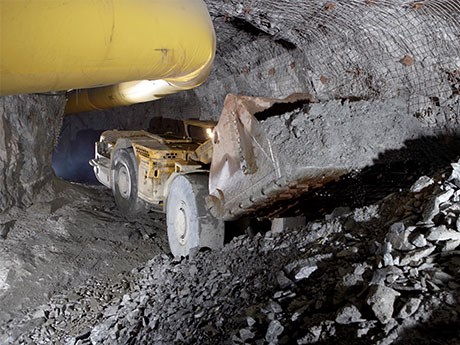A new detection system developed by Hard-Line Solutions of Sudbury alerts workers when they get too close to a piece of heavy equipment while working underground.
The new product will increase safety for workers with the aim of preventing injury or death on the job. “There have been incidents in the mining industry where these sorts of things happen because people become complacent with using a remote control,” said Max Gray of Hard-Line Solutions. “They get too close to it, they make an error, and all of a sudden it’s too late for them to react. This system will warn them so they can react.”
Integrated into Hard-Line’s Muckmaster Radio Remote Control System, Prox detects when a remote operator enters a zone around the piece of machinery being operated. When a zone is breached, the system emits an audible and visual warning and can be programmed to slow or stop the machine automatically.
Other proximity detection systems are on the market, but they operate as separate wireless systems, Gray said. Because both run on radio signals, there’s the potential for the two systems to interfere with each other, and both could fail.
Because Prox is integrated into Hard-Line’s system, it eliminates the opportunity for interference. Vice- resident Ryan Siggelkow said the company had been researching the idea for about four years.
Predictability
“We’ve seen many systems that are not predictable,”
Siggelkow said. “They’ll (trigger an alert) within 30 feet one time and within 15 feet the next time, and that, to us, wasn’t good enough. We finally found one that actually was very predictable and repeatable.”
The system Hard-Line eventually chose was originally developed by another company for use in coal mining, so it had to be adapted for a hard-rock environment.
Radio signals react differently underground in a hard rock environment than they do surrounded by coal, a softer material.
Testing
When tested at the NORCAT test mine, “it performed perfectly,” Gray said.
“We’ve projected that we can probably sell 50 to 100 systems in the first year of launching it and that’s probably a conservative estimate,” Gray said. “Right now, we’re going to be moving this in Ontario and Quebec … and we’re negotiating right now for our South American offices (Chile, Peru) and also for the Australian market.”
Customer needs are also behind the development of a second safety system launched in the last few months. Developed at the request of Xstrata Nickel (now Glencore), Entry Alert is a warning system that notifies both remote operators and mine personnel when someone enters a stope.
A light beam spans the stope entrance while a strobe light flashes to notify pedestrian and vehicle traffic that remote mucking is in progress. If the light beam is broken by entry into the area, the strobe at the operator station is immediately activated, notifying the operator.
It’s a simple solution, but one Gray said can make a significant impact on underground safety.
“One death is too many,” Gray said. “It’s dangerous down there, so the more a company can do to protect its workers, and the more the employees can do to protect themselves, the better it is for everybody.”
Glencore was so satisfied with the result that it now plans to install it throughout the mine. Gray said other companies have expressed interest in it as well.



